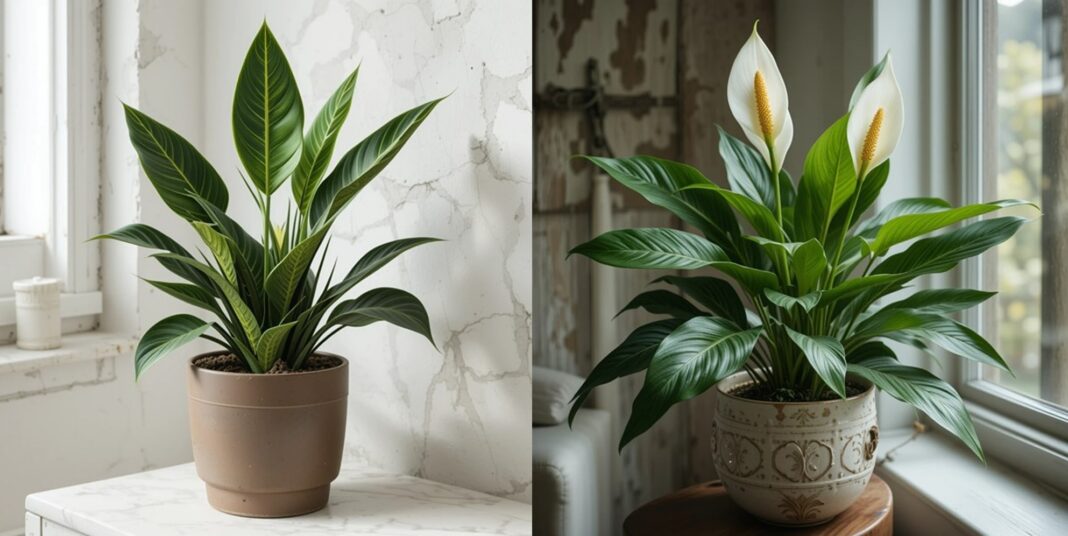Plants are natural carbon breathers and they offer coolness to the area around them. Which also explains how effective they are to be placed in our immediate surroundings. The sighting of them refreshes our minds and which then energize our body. Placing them inside our home and offices are a neat trick to get more productive in our own ways. Let’s explore more about that
1. Indoor plants may help reduce stress levels

A 2015 study shows that caring for indoor plants effectively reduced stress levels in participants. Some plants can remove dust, airborne pollutants and allergens. Interacting with plants can suppress sympathetic nervous system activity very much and lower blood pressure. Spending time around plants can improve memory retention and help you focus on every tasks well. These plants help maintain optimal humidity levels because they release moisture through transpiration.
a. Snake Plant:NASA uses this plant, which can improve concentration, sleep and reaction times.
b. Peace Lily: This plant purifies the air and adds humidity to the surroundings.
c. English Ivy: It can help soothe allergies, tension and asthma.
d. Spider Plant: This plant is easy to take care of and can improve mental health and reduce stress.
2. Real plants may sharpen your attention
In one study conducted not so long ago, students who sat in a class room with a real plant had better attention and concentration than those in other class rooms. Children in class rooms with green plants performed better on tests of selective attention. Plants can improve mood and vitality, and boost feelings of happiness and activity. And plants can also have neuroprotective effects. Plants can increase feelings of well being and calm, while decreasing negative emotions like depression and anxiety. Caring for plants can reduce psychological and physiological stress. They can mainly boost creativity. Important thing to understand is, if you have children or pets, its important to know which plants are toxic. Keep an eye out for species that exacerbate your symptoms if you have allergies or asthma.
a. Boston Fern: A plant with soft, green leaves that can remove toxins and maintain humidity.
b. Philodendron: An easy to maintain plant that’s good for offices.
3. Working with plants can be therapeutic
Horticultural therapy, which involves working with plants, can be helpful for people with mental illness. Observing nature or working with plants can reduce stress, fear, anger and sadness. Horticultural therapy can increase feelings of well being in people with depression, anxiety and other conditions. Working with plants can help improve memory and coordination and it also helps improve problem solving skills. And it can help dexterity as well. Therapeutic gardens are designed to be safe and comfortable, and to invite exploration. They can stimulate senses and build confidence. Horticultural therapy has been around for centuries. The “Father of American Psychiatry”, Benjamin Rush, observed that gardening had a favorable impact on mental health.
4.Plants could hasten your recuperation from sickness
Simply looking at greenery can have a calming effect, lowering stress hormones which can positively impact healing. Being surrounded by plants can uplift your spirits and promote a more positive outlook, which is important for recovery. Research indicates that patients with access to plants may require less pain medication during recovery. Many indoor plants can help filter pollutants from the air, contributing to a healthier environment for healing. Caring for plants can provide a sense of purpose and encourage a more mindful approach to health.
a. Lemon Balm: A fragrant herb that can improve mood.
5. Plants may boost your productivity
Plants can add variety, texture, and color to a space, which can boost creativity and productivity. Some plants can absorb harmful substances like benzene and formaldehyde and they can contribute to better air quality. One study found that participants who worked with plants had lower stress responses than those who worked with computers. Employees who have plants in their workspace feel more responsible and engaged, which can increase productivity and efficiency. Another study found that patients in a rehab center who had plants in common areas reported greater wellbeing.
a. Sansevieria Trifasciata: a practically indestructible plant that helps remove pollutants.
b. Zz Plant: an indoor plant that can help reduce stress.
6. Plants could completely change the way you think about your job
Plants with dense foliage can absorb sound waves, which can be helpful in open plan offices. Plants can help you feel more, calm and relaxed, which can help you cope with daily pressures. It can remove toxins from the air, and some can even help with office equipment related particles. Plants can help you focus and be more creative, which can lead to better performance. The sight of plants can uplift your mood and help you feel more positive. Learning to care for a plant can help lower anxiety and improve attention.
a. Pothos: a durable trailing plant that does best in bright and indirect light.
b. Areca Palm: a plant with long fronds that can trap air particles.
7. Plants could enhance indoor air quality

Plants absorb carbon dioxide and release oxygen through photosynthesis, which improves indoor air quality. Plants release water vapor through their leaves, and that balances humidity. They can remove harmful substances like formaldehyde, benzene, xylene from the air. Plants like peace lily can absorb mold spores through their leaves.
a. Aloe Vera: Removes formaldehyde and benzene.
b. Snake Plant: removes formaldehyde, benzene, xylene, toluene, nitrogen oxides.
c. Peace Lily: removes formaldehyde, benzene, xylene, and ammonia.
d. English Ivy: removes formaldehyde, benzene, xylene, and toluene.

